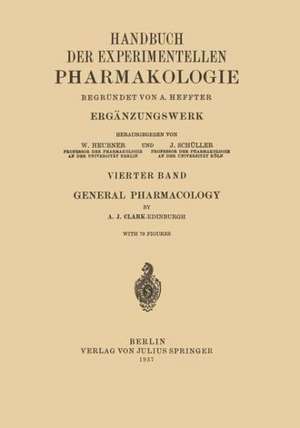General Pharmacology: Handbuch der Experimentellen Pharmakologie, cartea 4
Autor A. J. Clarken Limba Engleză Paperback – 1937
Din seria Handbuch der Experimentellen Pharmakologie
-
 Preț: 420.40 lei
Preț: 420.40 lei -
 Preț: 418.07 lei
Preț: 418.07 lei - 5%
 Preț: 404.88 lei
Preț: 404.88 lei - 5%
 Preț: 400.48 lei
Preț: 400.48 lei - 5%
 Preț: 401.56 lei
Preț: 401.56 lei - 5%
 Preț: 549.77 lei
Preț: 549.77 lei -
 Preț: 417.52 lei
Preț: 417.52 lei - 5%
 Preț: 456.60 lei
Preț: 456.60 lei - 5%
 Preț: 498.30 lei
Preț: 498.30 lei - 5%
 Preț: 407.97 lei
Preț: 407.97 lei - 5%
 Preț: 411.24 lei
Preț: 411.24 lei - 5%
 Preț: 404.88 lei
Preț: 404.88 lei -
 Preț: 530.08 lei
Preț: 530.08 lei - 5%
 Preț: 734.17 lei
Preț: 734.17 lei - 5%
 Preț: 399.19 lei
Preț: 399.19 lei -
 Preț: 425.20 lei
Preț: 425.20 lei - 5%
 Preț: 413.97 lei
Preț: 413.97 lei
Preț: 715.91 lei
Preț vechi: 753.60 lei
-5% Nou
Puncte Express: 1074
Preț estimativ în valută:
137.03€ • 148.90$ • 115.18£
137.03€ • 148.90$ • 115.18£
Carte tipărită la comandă
Livrare economică 21 aprilie-05 mai
Preluare comenzi: 021 569.72.76
Specificații
ISBN-13: 9783642896071
ISBN-10: 3642896073
Pagini: 240
Ilustrații: VI, 230 p. 1 illus.
Dimensiuni: 178 x 254 x 13 mm
Greutate: 0.42 kg
Ediția:Softcover reprint of the original 1st ed. 1937
Editura: Springer Berlin, Heidelberg
Colecția Springer
Seria Handbuch der Experimentellen Pharmakologie
Locul publicării:Berlin, Heidelberg, Germany
ISBN-10: 3642896073
Pagini: 240
Ilustrații: VI, 230 p. 1 illus.
Dimensiuni: 178 x 254 x 13 mm
Greutate: 0.42 kg
Ediția:Softcover reprint of the original 1st ed. 1937
Editura: Springer Berlin, Heidelberg
Colecția Springer
Seria Handbuch der Experimentellen Pharmakologie
Locul publicării:Berlin, Heidelberg, Germany
Public țintă
ResearchCuprins
1: Methods of General Pharmacology.- General Considerations.- Selection of Material.- Employment of Physicochemical Methods.- The Mathematical Interpretation of Biological Data.- Favourable Factors in Pharmacological Measurements.- Curves Relating Exposure to Drugs with Biological Effect.- Classes of Curves.- Discussion.- 2: The Cell as a Physicochemical System.- The Structure of Protoplasm.- The Cell Surface.- Cell Permeability.- Structure of Plasmatic Membrane.- Cell Organisation.- 3: General Characteristics of the Cell-Drug System.- Dimensions of Molecules and Cells.- The Number of Molecules in Single Cells.- The Number of Enzyme Molecules per Cell.- Lethal Doses of Drugs per Cell.- Effective Doses of Drugs per Cell.- Minimum Active Doses of Drugs per Organism.- Minimum Active Dilutions of Drugs.- Intracellular Administration of Drugs.- Types of Action of Drugs on Cells.- Discussion.- 4: Reactions between Drugs and Active Proteins.- Symplex Compounds.- Combination of Haemoglobin with Oxygen and Carbon Monoxide.- Antagonism of Oxygen and Carbon Monoxide.- Discussion.- 5: The Action of Drugs on Catalysts and Enzymes.- Poisoning of Inorganic Catalysts.- General Characters of Enzymes.- Enzyme Activity.- General Characters of the Poisoning of Enzymes.- Diphasic Actions of Enzyme Poisons.- The Rate of Action of Enzyme Poisons.- Relation between Concentration of Poison and Inhibition of Enzyme.- Discussion.- 6: Action of Heavy Metals on Enzymes in vitro and in vivo.- Action of Heavy Metals on Saccharase.- Concentration-action Relations of Heavy Metals and Enzymes.- The Action of Metals on Living Cells.- Relation between Metal Concentration and Action on Cells.- Minimum Lethal Concentrations of Heavy Metals.- Relative Toxicity of Metals.- Course of Reaction between Metals and Cells.- Diphasic Actions of Metals on Cells.- Discussion.- 7: Action of Various Enzyme Poisons in vitro and in vivo.- The Action of Dyes on Enzymes.- Action of Quinine on Enzymes.- Action of Quinine on Cells.- Action of Cyanide on Enzymes and Cells.- Diphasic Actions of Cyanide.- Phenol Compounds.- The Action of Narcotics.- Action of Narcotics on Enzymes.- Action of Narcotics on Cells.- Theories of Narcotic Action.- Discussion.- 8: Concentration-action Relations I.- (1) Classification of Concentration-action Curves.- Relations Depending on Mass-action p..- All-or-None Effects p..- (2) Concentration-action Relations Attributable to Mass-action Laws.- The Mode of Action of Acetylcholine p..- Amount of Aeetylcholine Acting on Cells p..- Individual Variation p..- Site of Action of Acetylcholine p..- Influence of Temperature on Acetylcholine Response p..- Specificity of Aeetyleholine Action p..- Possible Nature of Acetylcholine Receptors p..- Acetylcholine Esterase p..- Concentration-action Relations of Adrenaline p..- Dosage of Adrenaline p..- Concentration-action Relations Found with Various Hormones p..- Insulin p..- Thyroxin p..- Posterior Pituitary Principles p..- Sex Hormones p..- Various Alkaloids p..- Nicotine p..- Physostigmine p..- Other Alkaloids p..- 9: Concentration-action Relations II.- (3) Linear Relations; Action of Narcotics.- (4) All-or-None Responses.- Instrumental Errors p..- Distortion by the Cell of some Chemical Relation p..- Obligatory All-or-None effects p..- All-or-None Cellular Responses p..- Concentration-action Curves with Guinea Pig’s Uterus p..- Drugs Producing All-or-None Effects p..- Discussion p..- 10: Quantitative Pharmacology and the Theory of Humoral Transmission.- Quantitative Data.- Rate of Action.- Concentration-action Relations.-Specific Antagonisms.- Discussion.- 11: Kinetics of Drug Action.- Sources of Error in Kinetic Measurements.- (1) Kinetics of Reactions in Heterogenous Systems.- (2) Kinetics of Cell Reaction.- Delays in Drug Action Due to Diffusion to Cell Surface p..- Penetration of Cells p..- Delay in Biological Response p..- (3) Maximum Rate of Drug Action.- 12: The Rate of Action of Drugs on Cells.- (1) Curves Relating Time and Graded Action.- The Shapes of Time-action Curves p..- (2) Curves Relating Time and All-or-None Effects.- Kinetics of Protein Precipitation p..- Precipitation of Protein by Phenol p..- (3) Time Action Curves as Expressions of Variation.- Calculation of Time-action Curves p..- Time Relations of Toxic Action of Copper on Algae p..- (4) Implications of Monomolecular Theory.- Quantitative Measurements of Drug Uptake p..- Drug Actions as Chain Processes p..- (5) Mortality Curves.- (6) Action of Radiations.- Discussion p..- 13: Time-concentrations Curves.- (1) Form of Curves and Possible Significance.- (2) Time-concentration Curves of Nerve Paralysis.- (3) Time-concentration Curves with Various Drugs.- (4) Time-concentration Relations in Disinfection.- (5) Toxic Vapours.- Deviation of Narcotics p..- Time-concentration Curves of Anaesthetics p..- Time-concentration Curves of Hydrocyanic Acid p..- Irritant Gases p..- Discussion p..- 14: Individual Variation of Response to Drugs.- Methods of Measurement of Individual Variation.- Skew Variation in Biological Material.- Normal Equivalent Deviation.- Errors in Construction of Characteristic Curves.- Uniformity of Population.- Errors of Sampling.- 15: Relation between Various Types of Curves Expressing Response of Cells to Drugs.- (1) Concentration-action Curves as Expressions of Individual Variation.- Virus Infections p..- Discussion p..- (2) Characteristic Curves as Expressions of Chemical Processes.- (3) Correlation between Concentration-action Curves and Characteristic Curves.- Examples of Skewed Characteristic Curves p..- All-or-None Effects p..- Discussion p..- (4) Drug Responses and Individual Variation.- 16: Special Problems Relating to Variation of Populations.- Uniformity of Population.- Influence of Sex, Age and Weight on Response to Drugs.- Seasonal Variations in Sensitivity.- Variation in Human Populations.- Hypersensitivity and Idiosyncrasy.- Margin of Safety with Massive Doses.- Disinfection, etc..- 17: Quantitative Aspects of Drug Antagonism and of Drug Synergism.- The antagonism of cyanides by narcotics.- Selective Antagonisms with Haemoglobin.- Antagonism in Enzyme Poisoning.- Acetyl Choline-Atropine Antagonism.- Adrenaline-Ergotoxine Antagonism.- Synergists of Adrenaline.- Comparison of Antagonisms found with Enzymes and with Hormones.- 18: Qualitative Aspects of Drug Antagonism.- Antagonism of Adrenaline.- Chemical Structure of Acetyl Choline Antagonists.- Acetyl Choline Antagonism in Different Tissues.- Analysis of Drug Actions by Drug Antagonisms.- General Theory of Drug Antagonisms.- 19: Alternative Theories of Drug Action.- Monomolecular Theory.- The Potential Theory of Drug Action.- Phasic response of cells.- Arndt-Schulz Law.- Drug Responses as Expression of Individual Variation.- Weber-Fechner Law.- Discussion.- 20: Quantitative Aspects of Chemotherapy.- Action of Metallic Compounds.- Action of Non-metallic Compounds.- Drug-resistance.- Discussion.- 21: Conclusion.- Index of Authors.- Index of Subjects.








